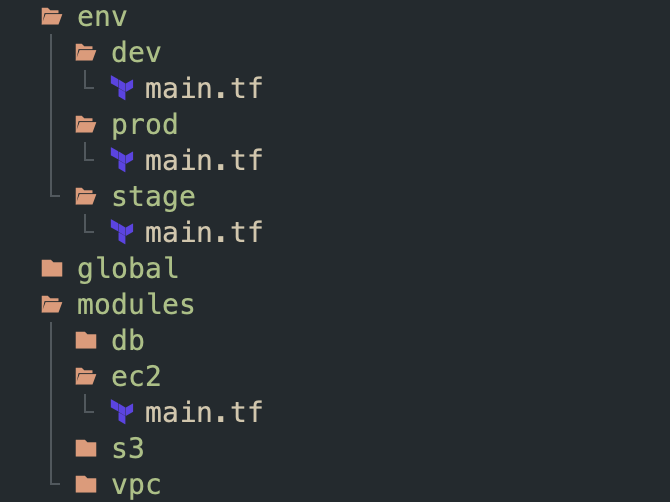🧱 모듈
Terraform은 기본적으로 현재 디렉토리에 있는 모든 .tf파일들을 불러와서, 하나의 구성 파일로 보고 의존 관계를 정리한 뒤, 자원을 순서에 맞게 생성한다.
이렇게 구성된 것들을 재사용할 수는 없을까?
모듈을 이용하면 코드를 재사용할 수 있다.
모듈은 재사용, 유지 관리 및 테스트 가능한 Terraform 코드를 작성하는 핵심 요소이다.
모듈은 조직 내에서 공유될 수도 있고, 온라인에 배포되어 사용될 수도 있다.
폴더에 있는 모든 Terraform 구성 파일 세트는 모듈이다.
모듈에서 직접 실행되면, 루트 모듈이라고 한다.
보통 모듈의 구성은 프로젝트의 modules/<리소스 종류>에 정의된다.
모듈 정의 및 사용 예시
간단한 EC2 서버 모듈을 하나 만들어보자.
1
2
3
4
5
6
7
8
9
10
11
12
13
14
15
16
17
18
19
20
21
22
23
24
25
26
27
28
29
30
31
32
33
34
35
36
37
38
39
40
41
42
43
44
45
46
47
48
49
50
51
52
53
54
55
56
57
58
59
|
# modules/ec2/main.tf
provider "aws" {
region = "ap-northeast-2"
}
resource "aws_instance" "example" {
ami = "ami-08943a151bd468f4e" # Ubuntu 22.04
instance_type = var.instance_type
vpc_security_group_ids = [aws_security_group.example_sg.id]
user_data = <<-EOF
#!/bin/bash
apt-get update -y
apt-get install -y apache2
echo "<h2> Hello World! </h2>" > /var/www/html/index.html
systemctl enable apache2
systemctl start apache2
EOF
user_data_replace_on_change = true
tags = {
"Name" = "ec2"
"environment" = var.environment
}
}
resource "aws_security_group" "example_sg" {
name = "myweb-sg"
vpc_id = data.aws_vpc.default.id
ingress {
from_port = 80
to_port = 80
protocol = "tcp"
cidr_blocks = ["0.0.0.0/0"]
}
egress {
from_port = 0
to_port = 0
protocol = "-1"
cidr_blocks = ["0.0.0.0/0"]
}
}
data "aws_vpc" "default" {
default = true
}
variable "instance_type" {
type = string # default가 없으면 required이다.
}
variable "environment" {
type = string
default = "dev" # default가 있으면 optional하다.
}
|
그 뒤, 이런 식으로 사용하면 된다:
1
2
3
4
5
|
module "myserver" {
source = "./modules/ec2" # 디렉토리를 맞춰줘야 한다.
instance_type = "t3.micro" # instance_type은 required이므로, 반드시 선언해야 한다.
}
|
모듈에는 변수를 지정해서 자리를 만들어놓고,
모듈을 사용하는 시스템에서 변수를 지정해서 사용하면 된다.
적용해보자. 모듈의 추가 또는 관련 정보를 바꿀 때에도 init이 필요하다.
1
2
|
terraform init
terraform apply
|
모듈 output 사용하기
출력 변수를 사용하여 퍼블릭 IP를 출력하게 할 수는 없을까? 물론 가능하다.
그러나, 이중으로 출력 작업이 필요하다.
모듈 정의에서 출력하고, 사용하는 루트 모듈에서 출력해야 한다.
모듈은 캡슐화되어있기 때문이다.
modules/helloserver/main.tf에 아래 스니펫을 추가하자.
1
2
3
4
|
output "public_ip" {
description = "The public IP address of the EC2 instance"
value = aws_instance.example.public_ip
}
|
그리고, 루트 모듈에도 정의해주자.
1
2
3
|
output "public_ip" {
value = module.myserver.public_ip
}
|
다시 적용해보자.
1
2
3
4
5
6
7
8
9
10
11
12
13
14
15
16
17
18
19
|
➜ terraform apply -auto-approve
module.myserver.data.aws_vpc.default: Reading...
module.myserver.data.aws_vpc.default: Read complete after 1s [id=vpc-063724386f9ff7382]
module.myserver.aws_security_group.example_sg: Refreshing state... [id=sg-0290d12641c27eac8]
module.myserver.aws_instance.example: Refreshing state... [id=i-09e6320eba5984532]
Changes to Outputs:
+ public_ip = "52.78.5.192"
You can apply this plan to save these new output values to the Terraform state, without changing any real infrastructure.
Apply complete! Resources: 0 added, 0 changed, 0 destroyed.
Outputs:
public_ip = "52.78.5.192"
➜ curl $(terraform output -raw public_ip)
<h2> Hello World! </h2>
|
local 변수
그러면, 모든 변수를 외부 루트 모듈에서의 사용으로부터 받아야 할까?
모듈 정의 내부에서만 편리하게 재사용할 수 있는 방법은 없을까?
이러한 문제를 해결해주는 것이 local변수이다.
아래 예시를 참고하자. 포트 번호를 local변수로 사용하고 있다.
1
2
3
4
5
6
7
8
9
10
11
12
13
14
15
16
17
18
19
20
21
22
23
24
25
26
27
28
29
30
31
32
33
34
35
36
37
38
39
40
41
42
43
44
45
46
47
48
49
50
51
52
53
54
55
56
57
58
59
60
61
62
63
64
65
66
67
|
provider "aws" {
region = "ap-northeast-2"
}
resource "aws_instance" "example" {
ami = "ami-08943a151bd468f4e" # Ubuntu 22.04
instance_type = var.instance_type
vpc_security_group_ids = [aws_security_group.example_sg.id]
user_data = <<-EOF
#!/bin/bash
apt-get update -y
apt-get install -y apache2
echo "<h2> Hello World! </h2>" > /var/www/html/index.html
systemctl enable apache2
systemctl start apache2
EOF
user_data_replace_on_change = true
tags = {
"Name" = "ec2"
"env" = var.environment
}
}
resource "aws_security_group" "example_sg" {
name = "myweb-sg"
vpc_id = data.aws_vpc.default.id
# local은 이렇게 사용할 수 있다.
ingress {
from_port = local.port
to_port = local.port
protocol = "tcp"
cidr_blocks = ["0.0.0.0/0"]
}
egress {
from_port = 0
to_port = 0
protocol = "-1"
cidr_blocks = ["0.0.0.0/0"]
}
}
data "aws_vpc" "default" {
default = true
}
# 로컬 변수 정의
locals {
port = 80
}
variable "instance_type" {
type = string
}
variable "environment" {
type = string
}
output "public_ip" {
description = "The public IP address of the EC2 instance"
value = aws_instance.example.public_ip
}
|
환경 나눠보기
dev, stage, prod등의 여러 환경으로 나눌 때, 모듈은 용이하다.
아래와 같이 구성을 할 수 있겠다(예시일 뿐이다):

이렇게 구성한 뒤, 각 환경에서 모듈에 각각 상이하게 입력변수들을 넣어서 사용하면 되겠다.
global과 같은 곳에는 IAM 등을 것을 정의하면 좋겠고,tfstate도 환경별로 원격 저장 벡엔드를 분리하면 좋을 것이다.
🏷️ 모듈 버저닝
이전에는 로컬에 버전을 참조하고 있는데, 대신 모듈을 VCS(Version Control System) 등에서 관리하도록 하면 더욱 편할 것이다.
모듈에 git tag등으로 버전 지정이 가능해지고, 모듈과 실제 환경들의 각 루트 모듈과의 분리된 저장으로 더욱 유연한 관리가 가능하다.
Terraform의 모듈은 Git, HTTPS등의 여러 모듈 리소스를 지원한다.
모듈을 별도의 레포지토리로 구성하여 이와 같이 커밋 및 푸시해주면 된다.
1
2
3
4
5
6
|
cd modules/ec2
git init
git add .
git commit -m "Initial commit"
git remote add origin "(URL OF REMOTE REPOSITORY)"
git push origin main
|
아래와 같이 git tag를 달아줄 수도 있다:
1
2
|
git tag -a "v0.0.1" -m "First Tag"
git push --follow-tags
|
이제, 리포트 레포지토리로부터 가져올 수 있다:
1
2
3
4
5
|
module "myserver" {
source = "github.com/<user>/<repo>//ec2?ref=v0.0.1"
instance_type = "t3.micro"
environment = "prod"
}
|
여기서 terraform init을 하면, 다운로드를 받는 것을 알 수 있다.
로컬 모듈을 제외하고, 원격 모듈이나 외부 모듈을 사용하는 경우, 반드시 다운받는다.
이러한 방법을 사용하면, 모듈을 업데이트하고 리모트 레포지토리에 푸시된 이후, 태그만 잘 업데이트된다면, 여러 버전의 모듈들을 사용할 수 있다.
🌐 외부 모듈 사용하기
Terraform Registry에는 다양한 모듈들이 올라와 있다.
이곳에서 여러 모듈을 사용할 수 있다.
예를 들어, AWS의 VPC 모듈을 사용한다고 해보자.
두 개의 가용영역을 사용하고, 각각 퍼블릭 서브넷, 프라이빗 서브넷, DB 서브넷을 하나씩 만들어 줄 것이다.
1
2
3
4
5
6
7
8
9
10
11
12
13
14
15
16
17
18
19
20
21
22
|
module "vpc" {
source = "terraform-aws-modules/vpc/aws"
version = "6.0.1"
name = "my-vpc"
cidr = "10.0.0.0/16"
azs = ["ap-northeast-2a", "ap-northeast-2c"]
public_subnets = ["10.0.1.0/24", "10.0.2.0/24"]
private_subnets = ["10.0.101.0/24", "10.0.102.0/24"]
database_subnets = ["10.0.201.0/24", "10.0.202.0/24"]
# Single NAT Gateway setup
enable_nat_gateway = true
single_nat_gateway = false
one_nat_gateway_per_az = true
tags = {
Terraform = "true"
Environment = "dev"
}
}
|
초기화 후 적용해보자:
1
2
|
terraform init
terraform apply
|
잘 만들어진 것을 볼 수 있다!

📚 요약
- Terraform은 현재 디렉토리의 모든
.tf파일들을 읽어서 하나의 구성으로 간주하는데, 이 하나의 단위를 모듈이라고 한다.
- 루트 모듈에서 여러 모듈들을 꺼내서 쓸 수 있다.
- git, https등 여러 방법으로 모듈을 가져올 수 있고, Terraform Registry등의 외부 모듈도 사용이 가능하다
- 모듈을 통해 반복되는 자원 정의를 재사용할 수 있고, 특히 환경 분리에 용이하다.


